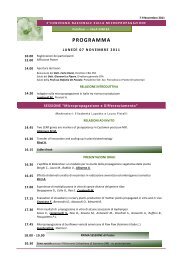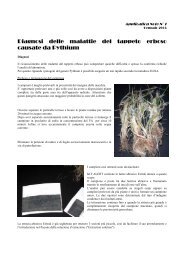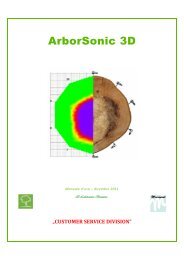BIOLOGY - microscopia.info
BIOLOGY - microscopia.info
BIOLOGY - microscopia.info
Create successful ePaper yourself
Turn your PDF publications into a flip-book with our unique Google optimized e-Paper software.
54<br />
Prepared Microscope Slides in Systematic Order<br />
On111f<br />
Ro212d<br />
Ro214e<br />
Cr113c<br />
Cr115d<br />
Cr128e<br />
Cr116e<br />
Cr134<br />
Cr139e<br />
Cr131e<br />
ONYCHOPHORA<br />
On111f Peripatus, connecting link between annelida<br />
and arthropoda, t.s. anterior region with leg *<br />
On112f Peripatus, region of gonads t.s. *<br />
On113f Peripatus, region of head t.s. *<br />
On114g Peripatus, anterior end sagittal l.s. *<br />
On115g Peripatus, middle part of the body, sagittal l.s. *<br />
Ro111d<br />
Ro211e<br />
Ro212d<br />
Ro213e<br />
Ro215e<br />
Ro214e<br />
Ro217e<br />
Ro218e<br />
ROTATORIA and BRYOZOA<br />
ROTIFERS and<br />
MOSS ANIMALS<br />
• Rotatoria, rotifers, strewn slide of mixed species<br />
w.m.<br />
• Plumatella, moss animals, w.m. or section<br />
• Plumatella, isolated statoblasts w.m.<br />
• Flustra foliacea, a marine moss animal, section<br />
of colony<br />
Flustrella hispida, moss animal (sea-mat),<br />
section of colony<br />
• Membraniphora, marine moss animal (seamat),<br />
section of colony<br />
Bugula, moss animal, part of colony w.m.<br />
Pectinatella, moss animal, part of colony w.m.<br />
CRUSTACEA<br />
CRUSTACEANS<br />
Cr111c • Daphnia, water flea, w.m.<br />
Cr112c Daphnia, ephippia, w.m.<br />
Cr1123c Daphnia, w.m. showing winter and summer<br />
eggs<br />
Cr113c • Cyclops, fresh water copepods, w.m.<br />
Cr114c • Cyclops, nauplius larva w.m.<br />
Cr120c • Small crustaceans, mixed species of fresh<br />
water plankton strewn slide w.m.<br />
Cr119d Artemia salina, brine shrimp, various developing<br />
stages on each slide, w.m.<br />
Cr115d • Balanus balanoides, common barnacle, nauplius<br />
larva w.m.<br />
Cr122d Bosmina, small crustacean w.m.<br />
Cr126d Bythotrephes, a cladoceran w.m.<br />
Cr128e Caprella, an amphipod w.m.<br />
Cr117e • Carcinus maenas, crab, zoea larva w.m. *<br />
Cr118e • Carcinus maenas, megalopa larva w.m. *<br />
Cr124d Cypris of Cirrepedia, cocoon stage, stained<br />
and w.m.<br />
Cr116e Gammarus, fresh water amphipod, entire specimen<br />
w.m.<br />
Cr160f Shrimp, entire small specimen w.m.<br />
Cr161d • Shrimp, t.s. of small specimen for general body<br />
structures<br />
Cr168d • Lepas anatifera, barnacle, w.m. of catching leg<br />
Cr169e Lepidurus apus, branchipode, w.m.<br />
Cr125d Leptodora, a large cladoceran w.m.<br />
Cr167f Lingula, brachiopode, t.s.<br />
Cr163e Mysis, shrimp from the Arctic ocean, w.m.<br />
Cr123d Podon and Evadne, selected from marine<br />
plankton w.m.<br />
Cr150f Statocyst of prawn, organ of equilibration with<br />
sensory hairs and statolith<br />
Cr135d • Astacus, crayfish, striated muscle l.s., ideal for<br />
the demonstration of striation showing large<br />
structures<br />
Cr132c • Astacus, gills t.s.<br />
Cr142c Astacus, stomach t.s.<br />
Cr134c • Astacus, intestine t.s.<br />
Cr137c • Astacus, liver t.s.<br />
Cr136c Astacus, green gland t.s.<br />
Cr138d • Astacus, ovary t.s. showing developing eggs<br />
in various stages<br />
Cr139e • Astacus, testis t.s. with spermatogenesis<br />
Cr1391g Astacus, testis t.s. specially selected for demonstration<br />
of meiosis and mitosis, carefully<br />
stained *<br />
Cr144c Astacus, sperm duct t.s.<br />
Cr131e Astacus, eye sagittal l.s. *<br />
Cr141f Astacus, cerebral ganglion t.s. *<br />
Cr133d Astacus, antenna (decalcified) t.s.<br />
Cr143e Astacus, pincers (decalcified) t.s.<br />
Cr140d Astacus, blood smear<br />
Cr1445e Astacus, t.s. of thoracic region of small specimen<br />
Cr1446e Astacus, t.s. of abdominal region of small specimen<br />
Cr1447f Astacus, near median sagittal l.s. of small specimen<br />
Cr165s Argulus foliaceus, fish louse w.m. *<br />
ARACHNIDA<br />
CHELICERATES<br />
Ar111e • Spider, entire young specimen, w.m.<br />
Ar112b • Spider, leg with comb, w.m.<br />
Ar113d • Spider, spinneret w.m.<br />
Ar114d Araneus, cross spider, spinneret w.m.<br />
Ar123e Spider, mouth parts of male w.m.<br />
Ar124e Spider, mouth parts of female w.m.<br />
Ar120f Spider, epigyne of adult female w.m. *<br />
Ar125d Spider, sagittal l.s. of abdomen for general<br />
study<br />
Ar126e Spider, sagittal l.s. of abdomen showing spinneret<br />
and spinning glands<br />
Ar127e • Spider, sagittal l.s. of abdomen showing the<br />
book or trachea lung<br />
Ar1272f • Spider, sagittal l.s. of abdomen with epigyne<br />
and ovary<br />
Ar1273g • Spider, sagittal l.s. of abdomen showing l.s. of<br />
the dorsal vessel<br />
Ar128f Spider, t.s. of cephalothorax showing the central<br />
nervous system<br />
Ar1281f Spider, cephalothorax with central nervous<br />
system l.s.<br />
Ar129g Salticus, spider, sec. of cephalothorax showing<br />
the telescope eyes *<br />
Ar130b Spider, portion of cobweb w.m.<br />
Ar171d Opilio sp., shepherd spider, sagittal l.s. of the<br />
body<br />
Ar172e Opilio sp., mouth parts w.m.<br />
Ar131c • Scorpion, t.s. through young specimen<br />
Ar132d Scorpion, sagittal l.s. through young specimen<br />
Ar133e • Scorpion, section selected to show the poison<br />
gland<br />
Ar134e Scorpion, section selected to show the book<br />
lung<br />
Ar138g Scorpion, entire young specimen w.m. *<br />
Ar1545g Amblyomma americanum, lone star tick,<br />
w.m. *<br />
Ar141g Argas persicus, fowl tick, w.m. of adult specimen<br />
*<br />
Ar142f Argas, six-legged larva w.m.<br />
Ar154s Boophilus annulatus, cattle tick, the vector of<br />
Texas fever, w.m. *<br />
Ar156g Dermacentor andersoni, Rocky Mountain<br />
wood tick, the vector of spotted fever, w.m. *<br />
Ar157e Dermacentor andersoni, ova w.m. *<br />
Ar158f Dermacentor andersoni, larva w.m. *<br />
Ar155s Dermacentor variabilis, American dock tick,<br />
w.m. *<br />
Ar146g • Ixodes sp., tick, w.m. of adult specimen *<br />
Ar147e Ixodes sp., larva w.m.<br />
Ar144g Ornithodorus, tick, carrier of relapsing fever,<br />
w.m. adult *<br />
Ar1442g Ornithodorus, six-legged larva w.m. *<br />
Ar159s • Rhipicephalus sanguineus, brown dog tick,<br />
w.m. *<br />
Ar153e • Demodex folliculorum, section through the<br />
skin with the parasites in situ<br />
Ar145d • Dermanyssus gallinae, chicken mite, w.m. *<br />
Ar1513d Hydrachna, mite of fresh water, w.m.<br />
Ar1512d Photia, beetle mite, w.m.<br />
Ar148e • Sarcoptes scabiei (Acarus siro), in section<br />
of diseased skin<br />
Ar149f Sarcoptes scabiei, w.m. of selected adult specimen<br />
*<br />
Ar1517g Syringophilus, parasitic mite of poultry, w.m.<br />
Ar150c • Tyroglyphus farinae, mite from meal, w.m.<br />
Ar151c Tyrolichus, cheese mite w.m.<br />
Ar1515e • Acarapis woody, Varroa, parasitic mite of bees<br />
w.m.<br />
Ar161g Pseudoscorpion, w.m. of young entire specimen<br />
*<br />
Ar180s Limulus, swordtail, trilobite larva w.m., the trilobite<br />
shaped larva is of interest for studies in<br />
phylogeny *<br />
Cr150f<br />
Cr115d<br />
Ar111e<br />
Ar124e<br />
Ar126e<br />
Ar127e<br />
Ar129g<br />
Ar133e<br />
Ar141g<br />
Ar147<br />
Cr133d<br />
Ar148e







